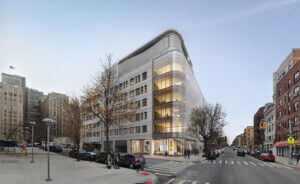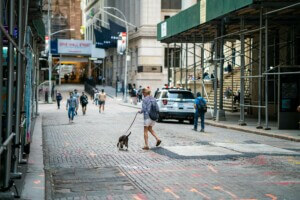The rise of autonomous vehicles (AVs) is inevitable and—depending on who you ask—they’ll either eliminate car crashes and save the environment, or muscle out pedestrians from the street, steal our personal data, and create biblical levels of gridlock in our cities. But despite the divide over how the technology should be implemented, the common thread that runs between apostles and bashers alike is the belief that cities, planners, and architects are woefully unprepared for the changes self-driving cars will bring.
In November 2017, the AIA held an event centered on the topic, “Anticipating the Driverless City,” and the furor seems justified following the death of a pedestrian at the grille of an autonomous Uber car.
“Planners think in 30-year increments, and autonomous vehicles are already hitting the streets today,” Nico Larco, co-director of the Sustainable Cities Initiative at the University of Oregon, said. “Urban planners should be terrified.”
Larco’s not wrong. Only a few states even have regulations for driverless cars, let alone ideas for designing a future without parking. With Ford launching self-delivering pizzas in Miami, Google’s Waymo rolling out an autonomous ridesharing service in Arizona, and driverless taxis making inroads in cities all over the world, architects and planners will either need to look ahead or be stuck in triage mode.

Sam Schwartz, former New York City Traffic Commissioner from 1982 to 1986 and founder of his eponymous traffic and transportation planning and engineering firm, has categorized the potential futures as “the good, the bad, and the ugly.”
The “good”
A utopic self-driving car scenario would have driverless cars constantly circulating and on the prowl for riders, while providing “first mile, last mile” access to and from souped-up mass-transit corridors.
If AVs truly take off and replace a sizable portion of manned cars on the street, then parking lots, garages, and driveways—not to mention thousands of square feet of on-street parking per block—would sit vacant. Walking, cycling, and autonomous (electric) buses would feature heavily in a multi-modal transit mix, and streets would narrow as bioswales and strips of public parks replaced parking spots. There has been movement on designing for that future; FXCollaborative, HOK, Arup, KPF, and other prominent firms have all put forward scalable designs for reclaiming the urban fabric. Speculation has already forced public officials in Pittsburgh to put together plans for integrating self-driving cars into the city’s fabric by 2030, and developers in New York are building flexible parking garages that can easily be converted for other uses.

However, the key to actually enacting any of these schemes lies in large-scale government intervention. Without a concerted top-down reclamation and conversion of unused streets, AV-centric zoning policies, or renewed investment in mass-transportation options, cities will never be able to integrate AVs into their infrastructure. The largest hurdle to achieving the “good” future isn’t technological, it’s political; even self-driving evangelists have conceded that a laissez-faire approach might result in increased traffic on the road.
The “bad”
Uber, Lyft, Google, and a raft of competitors are already jostling to bring self-driving taxis to market so that these companies won’t have to pay human drivers. Under the guise of preventing traffic fatalities—there were nearly 40,000 lives lost in the U.S. alone in 2017—the big players are lobbying all levels of government to allow their AVs on the street.
If vehicle miles traveled per person in AVs were allowed to increase without intervention, society could slide into an ugly scenario. This dystopic outcome would see mass transit hollowed out by a lack of funding and pedestrians shunted out of the streets in the name of safety. Studies have already shown that existing ridesharing services increase congestion and cause bus services to deteriorate, and if commuters get fed up with slow commutes and turn to ridesharing services, mass transit options could be sent into death spirals due to decreased revenue.

Driverless cars are often touted as being spatially efficient, especially as they can join each other to form road trains—tightly packed groups of vehicles moving along optimized routes. But considering how much space on the road 40 bicycles or 40 commuters in a bus would take up, the flaw in that thinking becomes self-evident. Even if artificial intelligence can route traffic more effectively than a human, putting more cars on the road offsets the gains in speed by decreasing the amount of space available.
Although computers might be great at coordinating with each other, the external human element will remain a wild card no matter what. Well-planned cities that prioritize walkability and ground-level experience would place pedestrians over passengers, but a worst-case scenario could see cyclists and walkers forced to wear locator beacons so that AVs could “see” them better, while hemmed in behind fencing.
The “ugly”
The worst driverless car scenarios take Le Corbusier’s famous claim that “the city built for speed is the city built for success” to heart. The high-speed arterial thoroughfares Corbusier envisioned in The Radiant City were realized in the destructive city planning policies of the 1950s and ’60s, but municipalities have spent heavily to correct their mistakes 50 years later. Much in the same way that widening roads actually worsens traffic, if planners and architects ignore or give deference to driverless cars and continue to prioritize car culture in their decisions, congestion, gridlock, and withered public transit systems are sure to follow.
The adoption of self-driving technology will likely birth new building typologies with unique needs, from centralized hubs where the cars park themselves to AV repair shops. As futurist Jeff Tumlin, principal and director of strategy at Nelson/Nygaard, points out, self-driving cars aren’t a new concept. Their lineage can be directly traced to ideas introduced by GE at the 1939 World’s Fair, but this is the first time that the technology has caught up with the vision. Planners and politicians have had 80 years to grapple with solutions; they can’t afford to take any longer.











